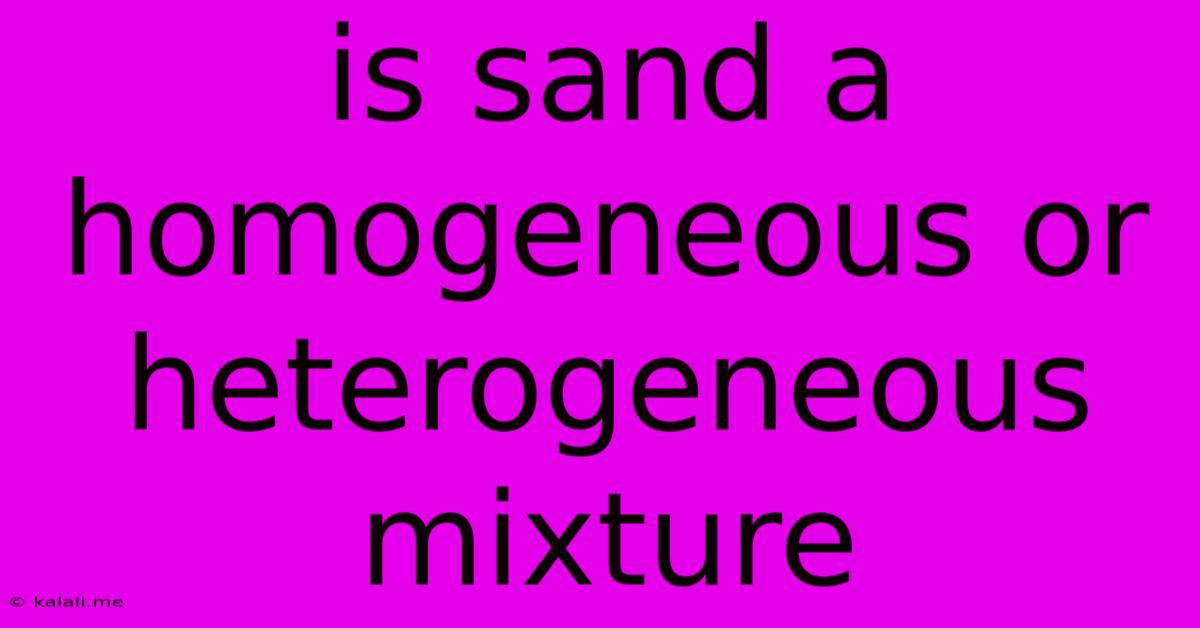Is Sand A Homogeneous Or Heterogeneous Mixture
Kalali
May 09, 2025 · 3 min read

Table of Contents
Is Sand a Homogeneous or Heterogeneous Mixture? A Deep Dive into the Composition of Sand
Sand might seem like a simple substance, but its classification as a homogeneous or heterogeneous mixture is a surprisingly nuanced question. This article delves into the composition of sand, examining its constituent parts and ultimately answering the question definitively. Understanding this will not only enhance your scientific knowledge but also provide valuable insights into the diverse nature of seemingly simple materials.
Sand, at first glance, might appear uniform. However, a closer look reveals a complex mixture of different materials. This leads us to the core question: is it a homogeneous mixture (uniform composition throughout) or a heterogeneous mixture (non-uniform composition)?
Understanding Homogeneous and Heterogeneous Mixtures
Before diving into the specifics of sand, let's clarify the definitions. A homogeneous mixture has a uniform composition, meaning the components are evenly distributed throughout the mixture. Think of saltwater – the salt is dissolved completely, and you can't visually distinguish the salt from the water. Conversely, a heterogeneous mixture has a non-uniform composition, with visible variations in the components. A salad is a great example – you can clearly see the different ingredients.
The Composition of Sand: A Closer Look
Sand is primarily composed of silica, in the form of silicon dioxide (SiO2). This is derived from the weathering and erosion of silicate rocks, particularly quartz. However, pure silica sand is rare. Most naturally occurring sand contains a variety of other minerals and materials, including:
- Feldspar: A common mineral group that contributes to the overall composition.
- Micas: Sheet silicate minerals that add to the sand's texture and properties.
- Calcite and other carbonates: Derived from seashells and other marine organisms, particularly in coastal sands.
- Fragments of other rocks and minerals: The weathering process incorporates bits of various rock types, adding to the diversity.
- Organic matter: Decomposed plant and animal matter, particularly in certain environments.
These components are often visible under magnification, showcasing their varied shapes, sizes, and colors. This visible heterogeneity is key to understanding the classification of sand.
Why Sand is a Heterogeneous Mixture
Due to the presence of these varied components, sand is definitively classified as a heterogeneous mixture. The different minerals and materials are not evenly distributed, and their presence varies depending on the location and geological history of the sand. Even if visually similar, examining a sample under a microscope will readily reveal the diverse composition. The varying sizes of the particles themselves also contribute to its heterogeneity.
While silica may be the dominant component, the presence of other minerals and particles prevents it from being considered homogeneous. The distribution of these components is not uniform throughout the sample.
Conclusion: The Complexity of Sand
Sand's apparent simplicity belies its complex and diverse composition. Its classification as a heterogeneous mixture is a clear consequence of this inherent variability. While the dominant component might be silica, the inclusion of other materials prevents the uniform distribution necessary for a homogeneous mixture classification. Understanding this sheds light on the geological processes that shape our environment and the surprising complexity of seemingly simple substances.
Latest Posts
Latest Posts
-
What Is The Common Multiple Of 8 And 12
May 09, 2025
-
Is The Number 29 Prime Or Composite
May 09, 2025
-
How Many Feet Is 132 Cm
May 09, 2025
-
What Are The Advantages Of Series Circuit
May 09, 2025
-
What Is The Percentage Of 34
May 09, 2025
Related Post
Thank you for visiting our website which covers about Is Sand A Homogeneous Or Heterogeneous Mixture . We hope the information provided has been useful to you. Feel free to contact us if you have any questions or need further assistance. See you next time and don't miss to bookmark.